Disney Cruise Line: Pompidou Dessert Experience at Remy
If you look at the topics of my blog posts, food comes up occasionally. Well, more often than not. Okay, I’ll take any excuse to review something that involves food. So when I heard about the Pompidou Dessert Experience which, in a nutshell, means a Remy dessert party with six courses of desserts in a row, I was signed up before the ink was dry on my Disney Cruise Line contract.
First, the details. The Pompidou Dessert Experience is available in Remy on the Disney Dream and Disney Fantasy on select sea days at 3:30 PM. It is an additional $50 per person (plus gratuity), and a wine pairing is available for $25. It must be booked in advance, although you may have luck booking it the day you arrive on the ship if there is availability. Remy is for ages 18 and up, and has a dress code that, according to Disney’s web site, means dress pants and dress shirt for men (ties and jackets optional) and dress or pantsuit for women (jeans, shorts, capri pants, sandals, flip-flops, or tennis shoes are permitted).
Now that’s out of the way, on to the desserts!
For some people, the idea of six desserts in a row might be a bit intimidating. Thankfully, these desserts, while filling as a whole, aren’t individually filling in their own right. Having done a meal at Victoria and Albert’s, I was concerned about how stuffed I would be, but the end result was being pleasantly full instead of stuffed and in sugar shock.
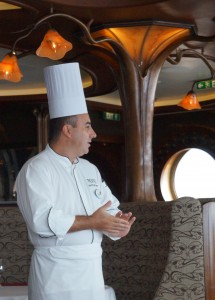
Upon arrival, we were escorted to our table. During our seating, there were a half dozen tables filled, and each table had its own serving team, plus the executive chef, plus the sommelier, plus the pastry chef and team in the kitchen. It felt like as each course was brought out, there were more serving people around to assist in the experience than there were people experiencing it!
Chef Cedrik shared with us why it is named after Pompidou. (If you don’t know, I’ll put the answer at the bottom of the article so you can also stump you friends.) With each course, he explained a bit about the history and inspiration of the desserts.
The desserts basically fell into two categories: the first four were designed to highlight the flavors of fruits, and the last two were made to explore the joy of chocolate.
The wine experience was explained (“Sauternes, La fleur D’or” 2010, France; “Tokaji Aszu, Disznoko”, 2007, Hungary; and “Apple Ice Wine, Domaine Pinnacle”, 2007, Canada), but as I’m not much of a drinker, we passed on that and went with still water. We also were given a glass of Taittinger champagne and tea and coffee complimentary during our experience.
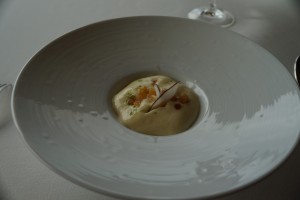
Course 1: Piña Colada.
I know, when most people think of piña colada, they think drink and not dessert. This first dish was a light mousse of sorts, and had the flavors of coconut and pineapple, along with a chip of coconut, some cooked pineapple, and lime zest. To make it, some carbon dioxide was infused into it to make the texture extremely light. It was a refreshing way to begin this experience.
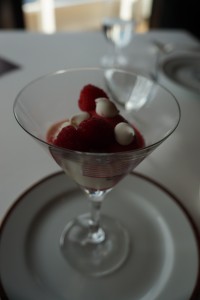
Course 2: Vacherin.
If I were stranded on a desert island, this is the dessert I would want to have with me. A vacherin is a traditional French dessert that is basically cream and fruit with meringue. This dessert not only blended those flavors amazingly well, it also was my favorite dessert of the whole experience. This dessert included vanilla ice cream alongside fresh raspberry sorbet with fresh raspberries on top. The meringue came in the form of what looked like white chocolate chips, but they were really tiny hand-crafted meringue bits. To finish the dessert, a hot raspberry juice was poured over the top at the table. Unlike the “raspberry sauce” that you may find everywhere, this was just raspberry juice that had been reduced to an amazingly potent zap of raspberry flavor. Because it was poured on hot, it melted everything together. This may be the best dessert that I have ever had in my life, beating out everything from Victoria and Albert’s, the Grand Marnier soufflé, and even the chocolate soufflé at Palo. Yes, it was that good.

Course 3: Blanc-Manger Passion
A blanc-manger is a lot like a panna cotta in its texture. For the preparation here, the passion comes in the form of passionfruit flavors, along with some crisps that had an almost walnut-type flavor to them. I’m not a huge fan of passionfruit, but this was a refreshing break before the more substantial courses to come. Overall, because I’m not amazingly fond of passionfruit, this was the only dessert that I would not order if I saw it in a restaurant. (And to note, at the beginning of the experience when we were presented the menu, we were asked if there were any items on the menu that we did not want or could not have, and there was a possibility of substitutions. I opted to try it all as-is, because like I tell my daughter often, you can’t know if you like or don’t like something until you try it.)
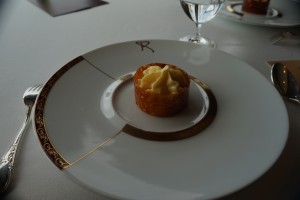
Course 4: Orange
The menu for this course simply said “Orange”. What was neat about this dessert is that it not only had orange flavors to it, but on the plate it looked somewhat like an orange sliced open. The “peel” was a crust akin to that on a crème brulee, and the inside was an orange mousse. Inside were hidden mandarin orange slices as well. If I had to describe it, I’d say that it was like an orange crème brulee turned on its side. The real trick to this dish was figuring out how to crack the crust so that you could eat it, but the crunch really helped make this dessert stand out from a lot of the prior desserts that were very soft on the palate.
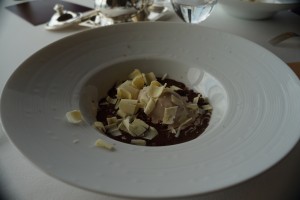
Course 5: Chocolate Soup
The full French name can be found on the menu at the end of this article, but I would brutally mangle it in writing, let alone in trying to pronounce it, so the chef suggested it can just be called “chocolate soup”. It was a great idea to have this immediately follow the orange dessert, as any lingering flavors blended well together. The dessert was amazing, but the presentation of the dessert is really what made it stand out in my view.
First, you started with a lightly spiced milk chocolate ice cream with a bit of chocolate crunch around it. Next, a hot, rich, dark chocolate “soup” was poured over it at the table, starting the melting process on the ice cream. Finally, Chef Cedrik came around and shaved white chocolate curls on top of the soup. Everything was designed to be blended together so that you got all the flavors at once, but also were still able to pick out their individual notes. I had to be reminded by my husband that it probably wouldn’t be good table manners to lick the bowl. This spoiled me for chocolate desserts from this point on.
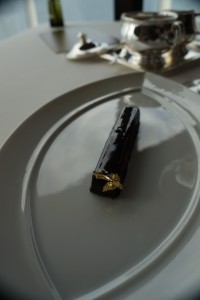
Course 6: Louis XV
Known to some as the best dessert in the world, and the signature dish of Alain Ducasse’s three-star Michelin restaurant, I feel somewhat ashamed with how I am going to describe this dessert. It was the best Kit-Kat that I have ever had—and I mean that with all the respect in the world and the best possible way. The dessert has a hazelnut praline layer at the bottom, which has the texture of the crispy wafer in the Kit-Kat. On top of that was a chocolate mousse holding it all together, and then it was enrobed in a dark chocolate glaze that was as smooth as glass. Oh, and if that’s not enough, a bit of edible gold leaf was added to kick it up a notch. It was a sliver behind the raspberry vacherin for my favorite dessert of the day, but depending on my mood (and if I hadn’t just eaten five other amazing desserts), this one might be my favorite.
After the meal, we were presented with a bag of macarons to take with us for another day. Chef Cedrik autographed our menus and was available for photographs. When all was said and done, the experience was about an hour in length.
Would I do it again? That’s a tough question to answer. I am glad that I’ve done it once, and feel that the price was very reasonable for the experience. I think that for a special occasion, it is a wonderful break from the everyday. Because it is such a special event, it isn’t something I would do every cruise, or even every other cruise. If you can work it into your schedule and your budget, it is worth trying at least once, however. As the name suggests, it is a dessert experience more than just a sampling of desserts, and if that is something that sounds of appeal, this would not be a waste of time and money.

Oh, and who was Pompidou? Because the restaurant is named Remy after the rat chef in Ratatouille, it is not surprising to learn that Pompidou was the patissier (pastry chef) in Gusteau’s restaurant. Likely the name came from Centre Georges Pompidou, an extravagant, multicultural complex in Paris with a design that is put together like a work of art—much like the work done to create a work of pastry art.
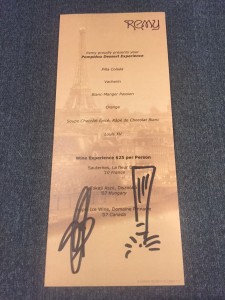





Comments are closed.